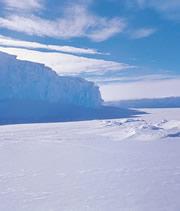 Microbes can survive in even the oldest ice.Punchstock
Microbes can survive in even the oldest ice.PunchstockMicrobes frozen in the oldest ice on Earth have been thawed out and brought back to life in the laboratory, providing new insights into how long living creatures can be frozen.
However the poor health of the thawed-out microbes has led their discoverers to cast doubt on a notion long cherished by some — that life on Earth arrived here on comets from outside our solar system.
After thawing ice from the Mullins and Beacon valleys in Antarctica, Kay Bidle, a microbiologist at Rutgers University, New Jersey, and colleagues discovered life in water from even the oldest samples — estimated to be around eight million years old. Microorganisms have been found alive in very old ice from another Antarctic site before now, but they date back only about 300,000 years, says Bidle.
"By examining microbes in ice as old as eight million years, our study significantly extends our understanding over which microbes retain viability," he notes.
“If you take the speed of a comet and take the distance it would need to travel it would take longer than eight million years to do that. In a comet the DNA would be completely deteriorated.”
Study author Kay Bidle
However, while some bacteria taken from 100,000-year-old ice reproduced quite readily, cells from the oldest ice multiplied only very slowly and their DNA was badly damaged. Studies of isolated DNA from the samples showed that it had become increasingly fragmented as time went on.
By analysing samples of ice varying from 100,000 years to eight million years, Bidle and colleagues calculated a 'DNA half-life'; the length of DNA fragments in the ice halves every 1.1 million years. This fragmentation is consistent with the idea that the DNA is being damaged by cosmic rays.
Bidle and his colleagues believe this half-life makes it highly unlikely that life on Earth was carried here on comets from outside our solar system. "If you take the speed of a comet and take the distance it would need to travel it would take longer than eight million years to do that. In a comet the DNA would be completely deteriorated," says Bidle.
However not all experts are convinced this work proves life was not carried to Earth by comets from outside our solar system. "I have to say I don't understand how that conclusion is drawn from the observation related to the Beacon Valley ice," says Richard Hoover, an astrobiologist at NASA's Marshall Space Flight Center in Huntsville, Alabama. Ice and rock could protect microbes deep inside comets from radiation, he says.
ADVERTISEMENT
Bidle and his team also point out implications of their work on Earth in terms of increasing the amount of genetic diversity available at the end of ice ages. Ice sheets in the process of melting could provide a kind of "gene popsicle" for other microorganisms that could acquire the newly defrosted DNA and incorporate it into their genomes. "Given the widespread influence of lateral gene transfer within microbial populations ... one can envision periods in Earth's history when large numbers of ancient genes became available as ice sheets melted," they write in the Proceedings of the National Academy of Sciences1.
In a parallel development, an international team of scientists has succeeded in cultivating microbes from eight-million-year-old samples of Antarctic permafrost from the same Beacon Valley location as Bidle's ice. David Gilichinsky, a geocryologist at the Russian Academy of Sciences, Moscow, and his colleagues found diverse populations of the oldest microorganisms discovered in permafrost to date.
And while Bidle thinks he has found life cannot have come to Earth from beyond our solar system, Gilichinsky and his colleagues offer some succour for those enthusiastic about extraterrestrial life closer to home. "Such studies could help define the limit of dormancy of frozen life on Earth and in ancient permafrost on other planets and, potentially, provide a model for Martian ecosystems," they write in their paper in Astrobiology2.
Visit our newsblog to read and post comments about this story.
